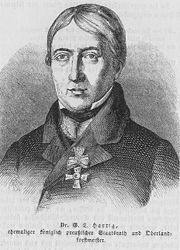
Georg Ludwig Hartig
Encyclopedia

Germany
Germany , officially the Federal Republic of Germany , is a federal parliamentary republic in Europe. The country consists of 16 states while the capital and largest city is Berlin. Germany covers an area of 357,021 km2 and has a largely temperate seasonal climate...
agriculturist
Agriculture
Agriculture is the cultivation of animals, plants, fungi and other life forms for food, fiber, and other products used to sustain life. Agriculture was the key implement in the rise of sedentary human civilization, whereby farming of domesticated species created food surpluses that nurtured the...
and writer on forestry
Forestry
Forestry is the interdisciplinary profession embracing the science, art, and craft of creating, managing, using, and conserving forests and associated resources in a sustainable manner to meet desired goals, needs, and values for human benefit. Forestry is practiced in plantations and natural stands...
, was born at Gladenbach
Gladenbach
-Location:The town of Gladenbach lies on the eastern edge of the Westerwald in the Hessian Highland . This part of the Lahn-Dill Highland is often also called the Gladenbach Uplands...
, in Hesse
Hesse
Hesse or Hessia is both a cultural region of Germany and the name of an individual German state.* The cultural region of Hesse includes both the State of Hesse and the area known as Rhenish Hesse in the neighbouring Rhineland-Palatinate state...
.
Life
After obtaining a practical knowledge of forestry at Harzburg, he studied from 1781 to 1783 at the University of GiessenUniversity of Giessen
The University of Giessen is officially called the Justus Liebig University Giessen after its most famous faculty member, Justus von Liebig, the founder of modern agricultural chemistry and inventor of artificial fertiliser.-History:The University of Gießen is among the oldest institutions of...
. In 1786 he became manager of forests to the prince of Solms-Braunfels
Solms-Braunfels
Solms-Braunfels was a County in what is today the federal Land of Hesse in Germany.Solms-Braunfels was a partition of Solms, and was raised to a Principality in 1742. Solms-Braunfels was partitioned between: itself and Solms-Ottenstein in 1325; itself and Solms-Lich in 1409; and itself,...
at Hungen in the Wetterau
Wetterau
The Wetterau is a fertile undulating tract, watered by the Wetter, a tributary of the Nidda River, in the western German state of Hesse, between the hilly province Oberhessen and the north-western Taunus mountains....
, where he founded a school for the teaching of forestry
Forestry
Forestry is the interdisciplinary profession embracing the science, art, and craft of creating, managing, using, and conserving forests and associated resources in a sustainable manner to meet desired goals, needs, and values for human benefit. Forestry is practiced in plantations and natural stands...
.
After obtaining in 1797 the appointment of inspector of forests to the prince of Orange-Nassau, he continued his school of forestry at Dillenburg
Dillenburg
Dillenburg is a town in Hesse's Gießen region in Germany. The town was formerly the seat of the old Dillkreis district, which is now part of the Lahn-Dill-Kreis....
, where the attendance thereat increased considerably. On the dissolution of the principality by Napoleon I of France
Napoleon I of France
Napoleon Bonaparte was a French military and political leader during the latter stages of the French Revolution.As Napoleon I, he was Emperor of the French from 1804 to 1815...
in 1805 he lost his position, but in 1806 he went as chief inspector of forests to Stuttgart
Stuttgart
Stuttgart is the capital of the state of Baden-Württemberg in southern Germany. The sixth-largest city in Germany, Stuttgart has a population of 600,038 while the metropolitan area has a population of 5.3 million ....
, whence in 1811 he was called to Berlin
Berlin
Berlin is the capital city of Germany and is one of the 16 states of Germany. With a population of 3.45 million people, Berlin is Germany's largest city. It is the second most populous city proper and the seventh most populous urban area in the European Union...
in a like capacity. There he continued his school of forestry, and succeeded in connecting it with the University of Berlin, where in 1830 he was appointed an honorary professor.

Theodor Hartig
Theodor Hartig was a German forestry biologist and botanist. He was the son of Georg Ludwig Hartig , a German agriculturist...
(1805–1880), and grandson Robert (1839–1901), were also distinguished for their contributions to the study of forestry.
Works (Selection)
- Anweisung zur Holzzucht für Förster, Marburg 1791
- Physicalische Versuche über das Verhältniß der Brennbarkeit der meisten deutschen Wald-Baum-Hölzer...etc., 1794
- Anweisung zur Taxation der Forste oder zur Bestimmung des Holzertrags der Wälder...etc., Gießen 1795
- Grundsätze der Forst-Direktion, Hadamer: Neue Gelehrten Buchhandlung 1803
- Lehrbuch für Förster und die es werden wollen...etc.,(3 vols.), Stuttgart 1808
- Kubiktabellen für geschnittene, beschlagene und runde Hölzer, 1815 (10th ed. Berlin, 1871)
- Lehrbuch für Jäger und die es werden wollen...etc., (2 vols.), Stuttgart 1810/1812
- Beitrag zur Lehre von der Ablösung der Holz-, Streu- und Weideservituten, Berlin 1829
- Die Forstwissenschaft in ihrem ganzen Umfange...etc., Berlin 1831
- Lexikon für Jäger und Jagdfreunde oder waidmännisches Conversations-Lexikon, 1836 (2nd ed. Berlin, 1859–1861)
Theodor Hartig and his son Robert also published numerous works dealing with forestry, one of the latter's books being translated into English by W. Somerville and H. Marshall Ward as Diseases of Trees (1894).
Literature
- Hans Joachim Weimann: Hartigiana - Kurze Lebens- und Familiengeschichte des Staatsrathes und Ober-Landforstmeisters Georg Ludwig Hartig und dessen Gattin Theodore, geborene Klipstein. Wiesbaden 1990
- ders: Georg Ludwig Hartig in: Biographien bedeutender hessischer Forstleute. Georg-Ludwig-Hartig-Stiftung & J. D. Sauerländer, Wiesbaden und Frankfurt am Main 1990. ISBN 3-7939-0780-5
- Theodora Hartig, Karl Hasel, Wilhelm Mantel (Hgg.): Georg Ludwig Hartig im Kreise seiner Familie. Kurze Lebens- und Familiengeschichte des Staatsrats und Oberlandforstmeisters Georg Ludwig Hartig. Göttingen 1976
- Autorenkollektiv: Georg Ludwig Hartig (1764–1837) zum 150. Todestage. (Festakt zum 11. März 1987 in Gladenbach; Vorträge und Dokumentation.) Mitteilungen der Hessischen Landesforstverwaltung , Band 21. Sauerländer, Frankfurt am Main 1987, ISBN 3-89051-064-7
External links
----

